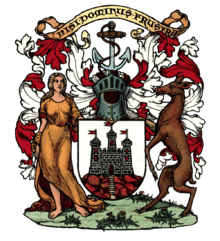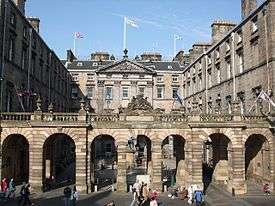City of Edinburgh Council
The City of Edinburgh Council is the local government authority for the City of Edinburgh. It was created in 1996 under the Local Government etc. (Scotland) Act 1994, with the boundaries of the post-1975 City of Edinburgh district of the Lothian region.
City of Edinburgh Council | |
|---|---|
| Full council election every 4 years | |
 Coat of arms | |
 Logo | |
| Type | |
| Type | |
| History | |
| Preceded by | City of Edinburgh District Council |
| Leadership | |
Leader of the Council | |
Chief Executive | Andrew Kerr since 27 May 2015 |
| Structure | |
| Seats | 63 |
 | |
Political groups |
|
| Elections | |
| Single transferable vote | |
Last election | 5 May 2017 |
Next election | 5 May 2022[2] |
| Motto | |
| Nisi Dominus Frustra | |
| Meeting place | |
 | |
| Edinburgh City Chambers | |
| Website | |
| www | |
History
Before 1368 the city was run from a pretorium (a Latin term for Tolbooth), and later from around 1400 from the Old Tolbooth next to St Giles' Cathedral. A Tolbooth is the main municipal building of a Scottish burgh providing council meeting chambers, a court house and a jail. The Old Tolbooth of Edinburgh was unique in that it housed both the Edinburgh Town Council and the Scottish Parliament. As a Royal Burgh the council was convened by a Lord Provost, who was assisted by a team of Bailies.
The Tolbooth had fallen into a state of disrepair by the 1560s, and was cramped, housing both the expanding Town Council of Edinburgh, and the Parliament of Scotland. Queen Mary believed the situation was intolerable, and requested extensive renovations take place. By 1639 Edinburgh Town Council paid for a new building, called Parliament House to be constructed nearby for the Parliament to meet in so they would no longer have to share the Old Tolbooth.[3]
In 1753 Edinburgh Town Council commissioned the construction of a new Royal Exchange as a meeting place for the city merchants, intended to rival the Royal Exchange of London. However the merchants preferred to carry on meeting at the Mercat Cross. Given the conditions of the Old Tolbooth and the underused status of the Royal Exchange, the council moved into the north range of the Royal Exchange in 1811 while a new fit for purpose permanent presence could be planned, and the Old Tolbooth was demolished. The former location of the Old Tolbooth (fully demolished in 1817) is now marked by the Heart of Midlothian, a heart Sett in the paving of Edinburgh's Royal Mile. The only remaining part of the Old Tolbooth is a door which Walter Scott recovered and added to his home Abbotsford.[4]
After The Canongate suburb merged into the city of Edinburgh in 1856, and the Canongate Tolbooth was abandoned, the north range of the Royal Exchange became too crowded once again and in 1893 the Council bought back the rest of the old Royal Exchange building and renamed it as the Edinburgh City Chambers.
The City Chambers initially housed Edinburgh Town Council from 1893 to 1895, when that body was replaced by City of Edinburgh Corporation.
From 1895 to the Local Government (Scotland) Act 1973 Edinburgh was administered by the single tier "Edinburgh Corporation", which covered the "City and Royal Burgh of Edinburgh". As such, the Edinburgh Corporation was responsible for local government services, such as the Edinburgh Corporation Transport Department (Edinburgh Corporation Tramways until 1928).
Bodies such as the Merchant Company of Edinburgh, the Incorporated Trades of Edinburgh and The High Constables of Edinburgh formed part of the corporation, contributing councillors and law enforcement officers. The Edinburgh Corporation had the power to institute these organisations via the granting of a "Seal of Cause". This empowered the societies as "a legal corporation with power to hold property, make its own by-laws and regulations". Other organisations to receive the "Seal of Cause" include The Royal Burgess Golfing Society of Edinburgh, who received their seal on 2 July 1800.[5] The history of the corporation lives on elsewhere around the city, for example in the name of the members of Muirfield golf club, who were granted a charter by the corporation in 1800 becoming "The Honourable Company of Edinburgh Golfers". The Corporation also awarded trophies to Edinburgh institutions, such as the silver arrow presented as a prize for archery in 1714 to the Royal Company of Archers, and the silver golf club presented to the The Honourable Company of Edinburgh Golfers.[6]
The Edinburgh Corporation also inherited from the Town Council the power to make Burgess (freemen) of the City of Edinburgh. The Edinburgh Corporation awarded its Burgess Tickets through the Lord Dean of Guild, an office in the Corporation holding the distinction of second citizen of Edinburgh, after the Lord Provost. Like the Corporation of the City of London, Burgess Tickets were often awarded along with a 'Freedom Casket' – a container to hold the ticket.
In 1975, Edinburgh Corporation was abolished.[7] The new two-tier system consisted of Lothian Regional Council (with responsibility for water, education, social work and transport) and the City of Edinburgh District Council (with responsibility for cleansing and libraries). The City of Edinburgh became a single-tier council area in 1996, under the Local Government etc. (Scotland) Act 1994, with the boundaries of the City of Edinburgh district of the Lothian region. The district had been created in 1975, under the Local Government (Scotland) Act 1973, to include the former county of city of Edinburgh; the former burgh of Queensferry, the district of Kirkliston and part of Winchburgh formerly within the county of West Lothian; and the district of Currie and the parish of Cramond formerly within the county of Midlothian.[7]
Today Edinburgh's council remains headed by the Lord Provost of Edinburgh, with six Bailies appointed by the council at large. Many of Edinburgh councils ceremonies and traditions date back to the days of the Edinburgh Corporation, such as the Edinburgh Ceremony of the Keys, where the Lord Provost symbolically hands the keys to the City of Edinburgh to the monarch, who hands them back to the Lord Provost proclaiming "that they cannot be placed in better hands than those of the Lord Provost and Councillors of my good City of Edinburgh".[8] The council continues to meet in the Edinburgh City Chambers and also holds and maintains properties from the days of the corporation, such as Lauriston Castle (which is used to host the Lord Provost's garden property), the Assembly Rooms and the Church Hill Theatre. Although no longer formally part of the City of Edinburgh Council, it retains a relationship with the Merchants Company, Incorporated Trades and High Constables of Edinburgh. The office of Lord Dean of Guild now operates from the Merchant Company of Edinburgh, and continues to issue Burgess tickets.[9]
Elections
The last election to the council was held on Thursday, 4 May 2017.[10]
Members of the council represent 17 electoral areas called wards. As a result of the Local Governance (Scotland) Act 2004, multi-member wards were introduced for the 2007 election, each electing three or four councillors by the single transferable vote system, to produce a form of proportional representation. Previously each of 58 wards elected one councillor by the first past the post system of election.
Wards
| Ward number | Ward name | Seats |
|---|---|---|
| 1 | Almond | 4 |
| 2 | Pentland Hills | 4 |
| 3 | Drum Brae/Gyle | 3 |
| 4 | Forth | 4 |
| 5 | Inverleith | 4 |
| 6 | Corstorphine/Murrayfield | 3 |
| 7 | Sighthill/Gorgie | 4 |
| 8 | Colinton/Fairmilehead | 3 |
| 9 | Fountainbridge/Craiglockhart | 3 |
| 10 | Morningside | 4 |
| 11 | City Centre | 4 |
| 12 | Leith Walk | 4 |
| 13 | Leith | 3 |
| 14 | Craigentinny/Duddingston | 4 |
| 15 | Southside/Newington | 4 |
| 16 | Liberton/Gilmerton | 4 |
| 17 | Portobello/Craigmillar | 4 |
Electoral History
| Election | Control | Administration | |
|---|---|---|---|
| 1972 | No overall control | Progressive-Conservative minority | |
| 1973 | No overall control | Conservative-Progressive minority | |
| 1974 | No overall control | Labour minority | |
| 1977 | Conservative | Conservative | |
| 1980 | No overall control | Conservative minority (Liberal support) | |
| 1984 | Labour | Labour | |
| 1988 | Labour | Labour | |
| 1992 | No overall control | Labour | |
| 1995 | Labour | Labour | |
| 1999 | Labour | Labour | |
| 2003 | Labour | Labour | |
| 2007 | No overall control | Lib Dem – SNP | |
| 2012 | No overall control | Labour – SNP | |
| 2017 | No overall control | SNP – Labour | |
See also
References
- Stephen, Phyllis (18 May 2017). "Interview with the new Lord Provost at City Chambers". Retrieved 9 February 2019.
- Council, The City of Edinburgh. "Upcoming elections". www.edinburgh.gov.uk. Retrieved 9 February 2019.
- https://www.rps.ac.uk/
- https://canmore.org.uk/site/52307/edinburgh-245-329-high-street-city-chambers
- "1735 Royal Burgess Golf Society - Scottish Golf History". www.scottishgolfhistory.org. Retrieved 9 February 2019.
- https://www.scottishgolfhistory.org/oldest-golf-clubs-societies/1744-honourable-company-of-edinburgh-golfers/
- "Local Government (Scotland) Act 1973". Legislation.gov.uk. Retrieved 16 April 2020.
- "Queen presides over Ceremony of the Keys in Edinburgh". BBC. 12 July 2010. Retrieved 13 April 2020.
- http://www.deansofguildscotland.co.uk/guildries/edinburgh/
- Council, The City of Edinburgh. "Local Government Election Results 2017 - The City of Edinburgh Council". www.edinburgh.gov.uk. Retrieved 6 February 2019.